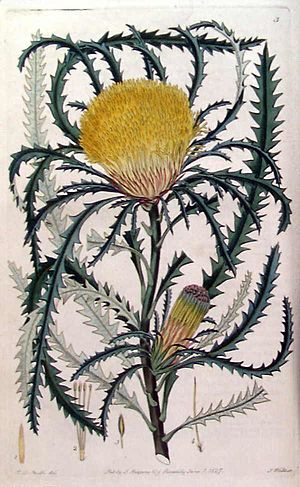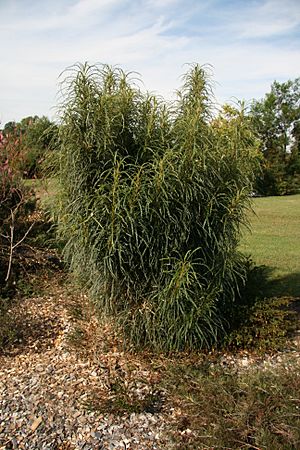Banksia prolata facts for kids
Quick facts for kids Banksia prolata |
|
|---|---|
 |
|
| B. prolata from Robert Sweet's 1828 Flora Australasica | |
| Scientific classification | |
| Genus: |
Banksia
|
| Species: |
prolata
|
| Synonyms | |
|
|
Banksia prolata is a special kind of bushy shrub. It is found only in Western Australia, meaning it is endemic to that area. This plant has long, thin leaves that can be jagged or deeply cut. Its yellow flowers grow in large clusters, and later, it forms egg-shaped seed pods called follicles.
Contents
What Does Banksia prolata Look Like?
Banksia prolata is a bushy shrub that can grow from about 0.4 to 3 meters tall. It does not have a special woody base called a lignotuber that helps some plants regrow after fire.
Its leaves are long and narrow, measuring about 110 to 300 mm in length. They are 12 to 18 mm wide and sit on a short stem called a petiole, which is 5 to 30 mm long. Each side of the leaves has between six and twenty-one sharp, triangular teeth.
The flowers are bright yellow. They grow in heads, with each head holding between 150 and 250 flowers. At the base of each flower head are hairy, lance-shaped leaves called involucral bracts, which are 14 to 30 mm long. The flower's outer part, called the perianth, is 23 to 40 mm long. The female part of the flower, the pistil, is 28 to 48 mm long.
This plant usually flowers from April to October. After flowering, it produces egg-shaped seed pods, or follicles, which are 8 to 12 mm long.
How This Plant Got Its Name
The Banksia prolata was first officially described in 1810. A botanist named Robert Brown gave it the name Dryandra longifolia. He published his description in a scientific journal called Transactions of the Linnean Society of London. He found the plant near Lucky Bay.
The name longifolia comes from two Latin words: longus, meaning "long," and folium, meaning "leaf." So, longifolia means "long-leaved."
In 1996, another botanist, Alex George, described three different types, or subspecies, of Dryandra longifolia. He published these descriptions in the journal Nuytsia:
- Dryandra longifolia subsp. archeos: This type has larger flower parts than the others. Its bracts are 25 to 30 mm long.
- Dryandra longifolia subsp. calcicola: This type is similar to the main species but has straight bracts up to 20 mm long.
- Dryandra longifolia subsp. longifolia: This type has bracts up to 20 mm long that curve downwards.
Later, in 2007, two scientists, Austin Mast and Kevin Thiele, moved all Dryandra plants into the Banksia group. However, the name Banksia longifolia was already being used for another plant. So, Mast and Thiele gave this species a new name: Banksia prolata. The word prolata comes from a Latin word meaning "drawn out."
The three subspecies were also renamed to archeos, calcicola, and prolata. These names are officially accepted by the Australian Plant Census.
Where Banksia prolata Grows
Each subspecies of Banksia prolata grows in slightly different places:
- Subspecies archeos is found among large rocks in thick bushes on Mount Arid. This area is part of the Cape Arid National Park.
- Subspecies calcicola grows in bushy areas west of Esperance Bay.
- Subspecies longifolia lives in scrubland near granite hills. You can find it between Cape Le Grand and Cape Paisley, both in the Cape Le Grand National Park. It also grows on Mondrain Island in the Recherche Archipelago.
Protecting Banksia prolata
The Western Australian Government's Department of Parks and Wildlife lists Banksia prolata as "not threatened." This means the species as a whole is not currently in danger.
However, some of its subspecies need more attention:
- Subspecies archeos is listed as "Priority Two." This means it is not well-known and is found in only one or a few locations.
- Subspecies calcicola is listed as "Priority Four." This means it is rare or close to being threatened.
- Subspecies prolata is listed as "Priority Three." This means it is also not well-known and found in only a few places, but it is not in immediate danger.


